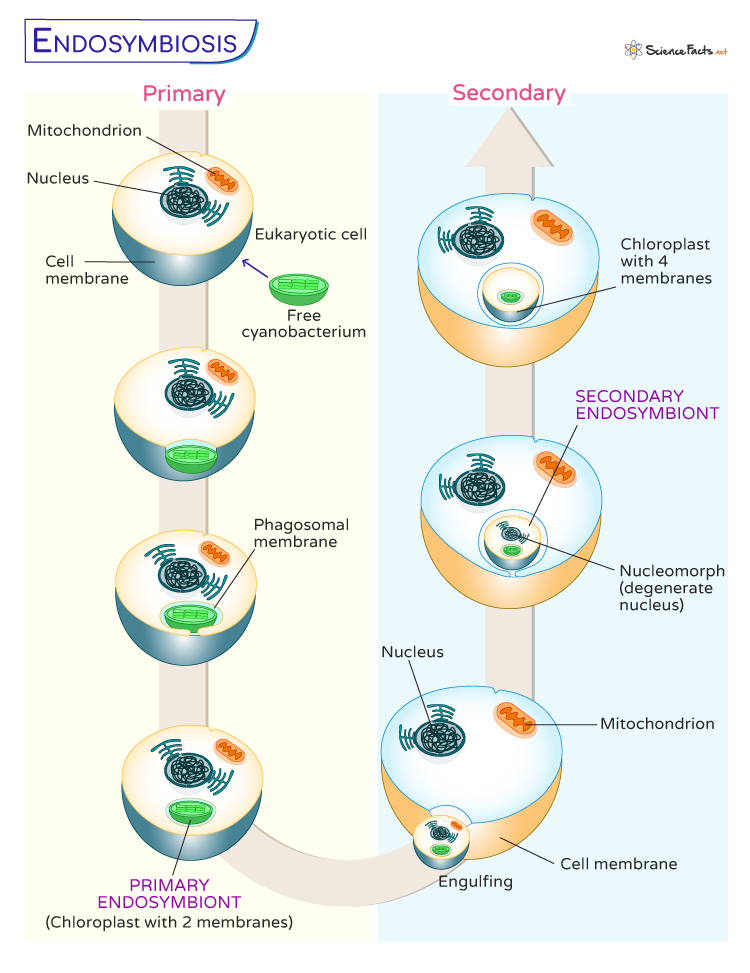Do you ever wonder why human cells are so complex? Even though we tend to think of nature as competitive—predators eating prey, immune systems battling intruders—there was a time in the history of biology when one of the most revolutionary events took place when ancient cells did something shocking: they reconciled with their "enemies" instead of killing them.
This remarkable alliance, referred to as **endosymbiosis**, radically changed life on Earth and enabled the existence of complex organisms such as humans. Let us delve into this intriguing biological tale that contradicts our normal assumptions regarding survival.
What Is Endosymbiosis?
Endosymbiosis occurs when one organism (the endosymbiont) settles in as a permanent resident within another organism (the host) and forms a symbiotic association. It is rather like the perfect tenant-owner arrangement: the host cell provides shelter and security, and the endosymbiont "pays rent" by furnishing valuable services—chiefly, energy production.
Why this is so special is that this contradicts what naturally happens. When something from the outside invades your body, your body will most often attempt to destroy it. In the same manner, when cells internalize other cells, these cells will often break them down. However, in endosymbiosis, the host cell kept its "intruder" alive, establishing one of the most successful associations in evolution.
How Did Endosymbiosis Happen
The evolutionary course got underway about 1.5-2 billion years ago when primitive eukaryotic cells (nucleus-containing cells) engulfed free-living bacteria here, aerobic bacteria that could use oxygen to produce energy with high efficiency. Instead of digesting the bacteria as a meal, host cells somehow managed to keep them whole.
Through many generations, these engulfed bacteria survived and continued to divide and live inside their hosts, being passed on to daughter cells whenever the host cell divided. Later, the same process happened with photosynthetic bacteria in the lineage that gave rise to plants.
As this symbiosis endured, the endosymbionts gradually lost autonomy. They never needed to live on their own outside the host, and the majority of their original cellular processes became useless. Through coevolution, the endosymbionts gave rise to what we today call **mitochondria** (from aerobic bacteria) and **chloroplasts** (from photosynthetic bacteria)—specific organelles that power our cells.
A fascinating aspect of this evolutionary process was the transfer of genetic material. Most of the endosymbionts' DNA migrated to the host cell's nucleus over time, rendering the process irreversible and establishing full cellular integration. Presently, mitochondria and chloroplasts possess only a small portion of their original genetic material—just enough to perform specialized functions.
The Evidence: How Do We Know This Happened?
Endosymbiotic theory is no conjecture—it's supported by firm scientific evidence:
1. Their Own Circular DNA
Mitochondria and chloroplasts both possess their own DNA, which is circular—like bacterial DNA and unlike linear DNA in our cell nuclei. That genetic material, although reduced in evolutionary time, bears clear bacterial origins.
2. Independent Reproduction
Unlike most cell components, chloroplasts and mitochondria divide on their own within the cell through a mechanism much like bacterial binary fission. They don't rely on the cell's normal division machinery.
3. Double Membranes with Bacterial Features
Mitochondria and chloroplasts both have double membranes—the inner one similar to a bacterial membrane and the outer one similar to the host's cellular membrane. Such double-membrane arrangement is a physical remnant of the engulfment process.
4. Bacterial-Like Ribosomes
Mitochondrial and chloroplast protein-making machinery (ribosomes) are closer to bacterial ribosomes than to the eukaryotic ribosomes in the cell's cytoplasm.
Why Endosymbiosis Matters
Endosymbiosis is a watershed in life history. In bringing about the establishment of complex eukaryotic cells with specialized organelles, it provided the means to multicellular animals, including plants, animals, fungi, and ultimately humans.
This cellular revolution permitted life to branch out and fill millions of ecological niches, resulting in the rich diversity of life we have today. Without the energy efficiency of mitochondria, complex animals such as ourselves could never have existed.
In perhaps its most basic sense, endosymbiosis disturbs our conventional conception of evolution by showing us cooperation as a driving force alongside competition. It shows us that every now and then in the natural world, coalition is better than combat—a marriage of erstwhile "enemies" creating more than the sum of its parts.
Conclusion
The endosymbiotic theory offers a fascinating insight into the evolution of life by revealing how free-living bacteria became essential components of our cells. The early symbiosis between bacterial and host cells not only changed cellular design but also prepared the way for all complicated life on Earth. Understanding of endosymbiosis enhances our appreciation of the interrelatedness of living things. Our bodies, composed of trillions of cells, each containing many mitochondria, are living testaments to this ancient connection. Every time we catch our breath, every time we stretch, is due to these once bacteria now powering our cells.
In a universe that prefers to emphasise competition and conflict, the story of endosymbiosis is a reminder that cooperation and symbiosis have also been equally powerful forces in shaping the amazing trajectory of life. Sometimes keeping your "enemies" close doesn't only work for both parties—it can change the world.
